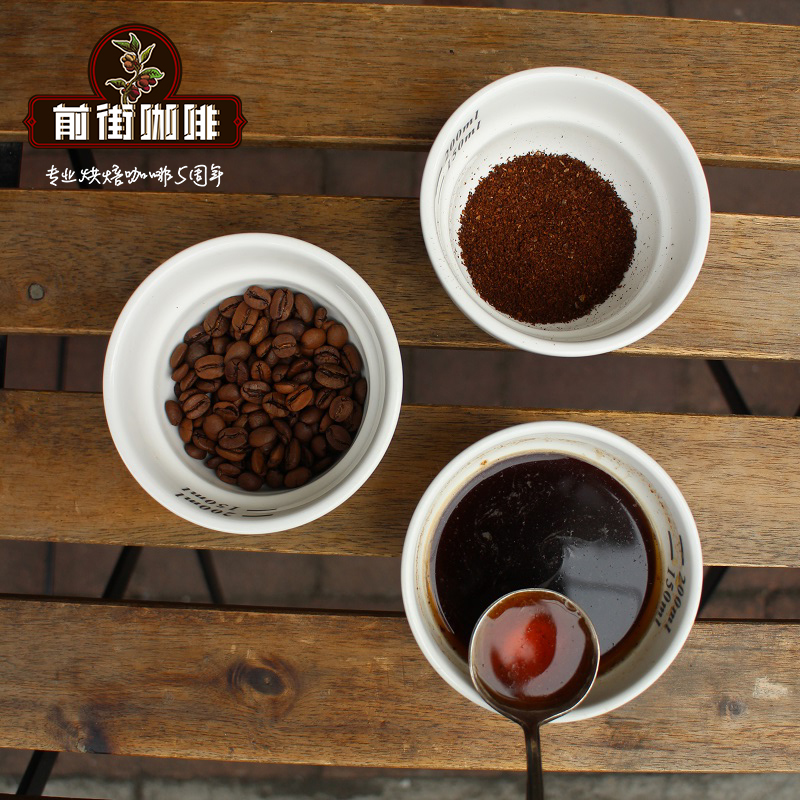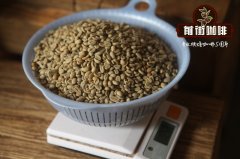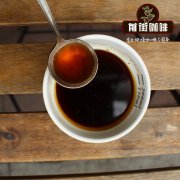How to grow high-quality coffee bean seeds? What are the planting conditions that affect the growth of coffee beans?

Professional coffee knowledge exchange more coffee bean information please follow the coffee workshop (Wechat official account cafe_style)
How to grow high-quality coffee bean seeds? What are the planting conditions that affect the growth of coffee beans?
Coffee beans are generally graded according to their size, defect rate and altitude. The size and defect rate of raw beans are easy to understand. Many people do not quite understand why some producing areas use the altitude of coffee beans as the basis for grading. Many coffee sellers also sell their coffee at high prices because they boast that their coffee is high altitude coffee. Why?
First of all, we should realize that the influence of geographical location on the flavor of coffee beans is important.
All coffee grows in the tropics, in fact, altitude has no direct effect on coffee, but altitude can affect the growth, development and quality of coffee through the redistribution of meteorological elements (temperature, light, heat, wind speed, rainfall, etc.). The tropical area between the Tropic of Cancer and the Tropic of Cancer produces the world's truly high-quality Arabica coffee. Central and South America, South Asia and some Pacific islands, and south-central Africa are also the most important coffee-growing areas in the world. The 3000-6000 ft (90-2000 m) high altitude provides ideal conditions for coffee to grow: an average frost-free climate of 60-70 degrees Fahrenheit (15-21 ℃) throughout the year, about 80 inches of moderate rainfall, and abundant sunshine. Coffee beans in cold mountain areas grow more slowly, and the slow ripening process makes coffee beans have higher sugar content, more interesting flavor and more mellow flavor. High elevations have a high displacement and produce more concentrated fruit flavors, and the best Arabica coffee-growing areas have very fertile soil, often in volcanic areas.
Coffee beans grown at high elevations are hard, dense and have the potential to give full play to their special flavor. The really amazing coffee growing areas are at high elevations, and these beans are only picked carefully during the mature season. Generally speaking, with the increase of altitude, the aroma of coffee becomes more and more prominent and unique (see figure). From the temperature and sweetness of Brazilian beans at 3500 feet to the soaring taste of Ethiopian coffee beans above 6000 feet, altitude will give coffee beans a more complex and subtle taste.
The rating of Central American coffee is based on the altitude at which the coffee grows.
Mexico, Honduras, Haiti and other countries are highly graded: Strictly High Grown (extremely high mountain bean, referred to as SHG), followed by High Grown (high mountain bean, referred to as HG)
Mexico is called Altura, which means "high" in Spanish, indicating that it is high-altitude coffee; Papua New Guinea appends the name "Mile High" to mark coffee beans grown in the highlands and mountains.
On the other hand, due to the cold climate and slow growth of coffee in alpine areas, the density of raw beans is higher and the texture is harder, and the more mellow and aromatic the coffee is, and it has a supple sour taste; on the other hand, in lower areas, the density of raw beans is smaller and the texture is less hard, the worse the quality of coffee is, so some people classify it as "hardness".
Guatemala, Nicaragua, El Salvador, Costa Rica and other countries are classified as follows
Grade growth height grade abbreviation
Strictly Hard Bean (extremely hard beans) about 1372 Murray 1524m SHB
Good Hard Bean (high hard bean) is about 914 GHB 1372m.
Hard Bean (hard beans) is about 610 HB (914m)
Pacific (Pacific Coastal area) about 300m Pacific 1000m
Practice shows that the effect of altitude on quality has exceeded that of genotype on quality. Viagra personally believes that the classification of coffee beans based on altitude is more scientific and reasonable than simply grading by size and defect rate, because to a certain extent, altitude classification is indirectly graded by taste, and beans with low altitude grow rapidly and large. the defect rate can be changed by selection, but the altitude cannot be changed.
According to the measurement, compared with the same kind of coffee beans, the higher the altitude, the greater the acidity and the smaller the concentration; on the contrary, the smaller the acidity, the greater the concentration. Therefore, for friends who like sour taste and do not require high concentration, high-altitude coffee is very suitable for you, it is your good coffee; for friends who do not like sour taste and require high concentration of coffee, the higher the altitude, the more unsuitable for them. No matter how high its quality is, it is also a waste product for itself. Therefore, the choice of altitude should be based on personal taste.
Secondly, how do we know if the coffee we buy is really high altitude? Coffee growth and reproduction has specific requirements for environmental conditions, sexual preference for calm wind, cool, shaded or semi-shaded environment. In other words, coffee can not be grown and produced in any environment. In other words, coffee production is regional. Most of the coffee producing areas in the world are distributed in tropical plateaus or high-altitude mountain areas. The heat in the equatorial area is high and can be planted to about 2000 meters above sea level; the heat on both sides of the Tropic of Cancer is relatively low, mostly below 1000 meters. In China, it is mainly distributed in Yunnan. Therefore, when making coffee well, we also need to understand the geography, climate and environment of the coffee producing area. Do more and drink more in order to better understand the different flavors of coffee.
Three key factors affecting the soil
According to the above, we know that wind soil will affect some characteristics of varieties, and some soil is more suitable for the growth of some varieties. At the same time, we can learn what kind of local conditions can make good coffee in the following content. There are three key factors:
1. Soil
Since the soil represents the land, the first key is of course the soil. Thiago said: "the minerals in the soil can affect the alcohol thickness and acidity of coffee." Keith says volcanic soil is ideal for growing coffee because it is rich in nutrients such as magnesium, phosphorus, potassium, calcium and zinc, which are needed for plant growth.
In addition, the volcanic soil has deep drainage, when the soil has more air circulation and is rich in organic matter, it can retain more water in the rainy season to prepare for the dry season. The soil will also directly affect the absorption of nutrients and minerals by plants.
two。 Climate
Coffee is usually grown in the producing countries of the "coffee belt", which extends all over the world, from the equator to Mexico and Myanmar to the north and to Brazil and Tanzania to the south.
Even in the coffee belt, there are still many different climate patterns, which are divided into a small range of weather and a large range of climate. Some coffee experts talk about the microclimate of coffee farms, meaning that the climate in a small area is significantly different from that in other areas, which may be caused by nearby canyons.
Keith says it's important to have a dry and wet season. The wet season contributes to the growth of coffee trees and fruits, and coffee trees absorb the nutrients they need. But when it comes to the harvest season, Rain Water is not a good thing, because Rain Water may break the fruit, slow down the drying efficiency of raw beans, and so on. As for the dry season, it is conducive to the harvest period, because the dry season helps coffee trees blossom, while flowering contributes to the growth of new fruits.
3. Altitude
The higher the altitude, the higher the sweetness and quality of the fruit. One reason is that high altitude increases the acidity of the fruit, which brings sweetness, which is similar to wine. The suitable height varies from breed to breed. The suitable height for "Arabica species" is about 800 Murray 2000 meters above sea level, while that for "Robusta species" is 0 Murray 800 meters. In fact, the "Robusta species" has few altitude restrictions, so in heavily planted Asia, you can often see a lot of coffee plantations on low-altitude flatlands.
4, rainfall: the suitable rainfall varies slightly according to different varieties. "Arabica species" is about 1200mm / year, "Robusta species" is about 2200mm / year, "Robusta species" is about 3000mm / year.
Temperature: the suitable temperature varies slightly depending on the variety. The "Arabica species" is more suitable for the environment of 20 ℃-25 ℃ degrees, while the "Robusta species" has a much larger tolerance range for temperature, as long as it is in the range of 24 ℃-36 ℃ degrees Celsius.
Although the data listed above, whether in terms of rainfall or temperature, are only approximate. But smart readers may be able to get a glimpse of why rainforest countries such as Southeast Asia and India have generally planted the cheaper Robusta beans. To tell you the truth, these conditions are generally more suitable for growing "Robusta beans".
Generally speaking, the height of coffee trees should be planted at about 800 meters above sea level, and the quality will be better. Some coffee gluttons even directly believe that there will be no good beans below 1000 meters above sea level. The author does not agree with such a classification, but it also reflects that the height has a certain impact on the quality of coffee beans.
Basically, coffee trees are native to the highlands of Ethiopia, so in the past coffee trees were also planted in mountainous areas with certain heights. Because most of the areas where coffee is grown are near the equator, the flat land in this area is obviously too hot for coffee trees. However, this specifically refers to the "Arabica species", but it is a different matter for the "Robusta species".
In addition, as mentioned earlier, the special geographical environment of each region often causes surprises under many exceptions, so readers need not be too obsessed with these data. For example, KONA coffee from Hawaii, which is almost as famous as Blue Mountain a few years ago, Huisun coffee from China, which has won an American Food Award, and coffee from Yunlin Gukeng Hebao Mountain, which has recently been vigorously promoted by the government, are all low-altitude coffee beans, but their quality is not necessarily bad. If readers are interested, they can try to compare them.
Having said that, there are many areas that attach great importance to the geographical condition of "planting height" (including some of the coffee gluttons mentioned above) and even become the standard for the grading of coffee beans in the region. Many bean-producing countries in Central America, including Guatemala (Guatemala), Costa Rica (Costa Rica), El Salvador (Salvador) and other regions, their coffee beans are graded according to the height of their producing areas. They believe that the higher the height of the producing area, the denser the texture (hard) of the coffee beans, and not only the taste is richer, but also the aroma is better, so the highest grade of coffee beans, Strictly Hard Bean (SHB, very hard beans), grow at a height of about 4,500 UV 6000 feet, while those with a growth height of 4000Mel 4500 ft are called "Hard Bean". As for the coffee beans produced in Pacific, the lower altitude area of the Pacific coast, they are the lowest grade beans.
Important Notice :
前街咖啡 FrontStreet Coffee has moved to new addredd:
FrontStreet Coffee Address: 315,Donghua East Road,GuangZhou
Tel:020 38364473
- Prev

How do you grow coffee beans? What kind of planting environment is needed for excellent coffee fruit? How to correct
Professional coffee knowledge exchange more coffee bean information please follow the coffee workshop (Wechat official account cafe_style) how to grow coffee beans? What kind of planting environment is needed for excellent coffee fruit? How to cultivate and plant correctly? Due to the physiological characteristics of coffee trees, there are limited areas in the world that can cultivate coffee beans commercially. It is mainly limited by temperature.
- Next

Pure pedigree water washing Yunnan small coffee beans Baoshan Tiebika what is the taste? In the end, Yunnan mouth
Professional coffee knowledge exchange more coffee bean information please pay attention to the coffee workshop (Wechat official account cafe_style) pure blood washing Yunnan small coffee beans Baoshan Tiebika taste? How does Yunnan taste? Based on some basic factors to judge whether a bean will taste good, nothing more than the following: look at beans: 1. Variety 2. Altitude 3. Treatment mode 4. Baking
Related
- Detailed explanation of Jadeite planting Land in Panamanian Jadeite Manor introduction to the grading system of Jadeite competitive bidding, Red bid, Green bid and Rose Summer
- Story of Coffee planting in Brenka region of Costa Rica Stonehenge Manor anaerobic heavy honey treatment of flavor mouth
- What's on the barrel of Blue Mountain Coffee beans?
- Can American coffee also pull flowers? How to use hot American style to pull out a good-looking pattern?
- Can you make a cold extract with coffee beans? What is the right proportion for cold-extracted coffee formula?
- Indonesian PWN Gold Mandrine Coffee Origin Features Flavor How to Chong? Mandolin coffee is American.
- A brief introduction to the flavor characteristics of Brazilian yellow bourbon coffee beans
- What is the effect of different water quality on the flavor of cold-extracted coffee? What kind of water is best for brewing coffee?
- Why do you think of Rose Summer whenever you mention Panamanian coffee?
- Introduction to the characteristics of authentic blue mountain coffee bean producing areas? What is the CIB Coffee Authority in Jamaica?

